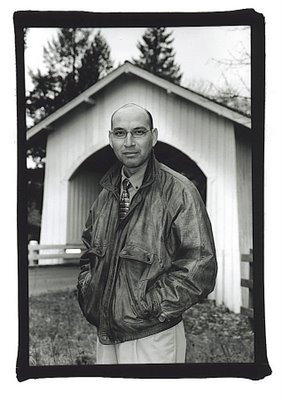#8 - Color Blind
Black and white are the colors of photography. To me they symbolize the alternatives of hope and despair to which mankind is forever subjected. - Robert Frank
 Old school newsphotographers are color blind. They cut their journalistic teeth in a time when most published images were black and white even though the stories they covered seldom seemed that way. But in 1982, all the rules began to change.
Old school newsphotographers are color blind. They cut their journalistic teeth in a time when most published images were black and white even though the stories they covered seldom seemed that way. But in 1982, all the rules began to change.
When USA Today debuted on newsstands--with a plethora of full color charts, graphics, and pictures--the photojournalistic world was never the same again. Suddenly, all wire service photographs needed to be taken using color negative film (despite the fact most were transmitted in black and white), as publications worldwide demanded more visual options attempting to emulate the growing popularity and success of our "nation's newspaper".
For the contemporary digital photographer, this "new" system presents no problems as most, if not all, work is performed in color from the start anyway. But for the traditional film photographer, two major obstacles resulted: first, a completely separate darkroom unit needed to be packed and set-up, plus effective color film photography often required the use of auxiliary lighting systems which added to the baggage burden as well as infringed on the spontaneity of the very moments all newsphotographers strived to capture.

But most importantly, photographers faced an ethical dilemma while working in color: did this medium enhance, simplify, or support the visual message/story; or did it alter, beautify, or disguise it? Purists often condemn color for color's sake, and a great illustration of this argument comes from the following assignment . . .
When a Holocaust monument in Skokie, IL, was vandalized the night before its dedication, the focus of the story immediately shifted from general to spot news, and I arrived at the scene prepared for the worst. Surprisingly, the ceremony continued without fail, the crowd of supporters ironically strengthened by the hateful set-back. Covering the event with color negative film, I filed a black and white image (which garnered a great deal of newspaper play) and much to my amazement, the alternative color print I had prepared never received a single request! In my opinion, and in this particular instance, the black and white photo articulated the story best although I'm sure this statement could generate a great deal of debate.
Whether your preference in photojournalistic photography is color or black and white, clearly this judgment seems highly subjective in nature. However, I'm just thankful I began my career back when all newsphotographers were color blind.
To see in color is a delight for the eye but to see in black and white is a delight for the soul. - Andri Cauldwell
 Old school newsphotographers are color blind. They cut their journalistic teeth in a time when most published images were black and white even though the stories they covered seldom seemed that way. But in 1982, all the rules began to change.
Old school newsphotographers are color blind. They cut their journalistic teeth in a time when most published images were black and white even though the stories they covered seldom seemed that way. But in 1982, all the rules began to change.When USA Today debuted on newsstands--with a plethora of full color charts, graphics, and pictures--the photojournalistic world was never the same again. Suddenly, all wire service photographs needed to be taken using color negative film (despite the fact most were transmitted in black and white), as publications worldwide demanded more visual options attempting to emulate the growing popularity and success of our "nation's newspaper".
For the contemporary digital photographer, this "new" system presents no problems as most, if not all, work is performed in color from the start anyway. But for the traditional film photographer, two major obstacles resulted: first, a completely separate darkroom unit needed to be packed and set-up, plus effective color film photography often required the use of auxiliary lighting systems which added to the baggage burden as well as infringed on the spontaneity of the very moments all newsphotographers strived to capture.

But most importantly, photographers faced an ethical dilemma while working in color: did this medium enhance, simplify, or support the visual message/story; or did it alter, beautify, or disguise it? Purists often condemn color for color's sake, and a great illustration of this argument comes from the following assignment . . .
When a Holocaust monument in Skokie, IL, was vandalized the night before its dedication, the focus of the story immediately shifted from general to spot news, and I arrived at the scene prepared for the worst. Surprisingly, the ceremony continued without fail, the crowd of supporters ironically strengthened by the hateful set-back. Covering the event with color negative film, I filed a black and white image (which garnered a great deal of newspaper play) and much to my amazement, the alternative color print I had prepared never received a single request! In my opinion, and in this particular instance, the black and white photo articulated the story best although I'm sure this statement could generate a great deal of debate.
Whether your preference in photojournalistic photography is color or black and white, clearly this judgment seems highly subjective in nature. However, I'm just thankful I began my career back when all newsphotographers were color blind.
To see in color is a delight for the eye but to see in black and white is a delight for the soul. - Andri Cauldwell


0 Comments:
Post a Comment
<< Home